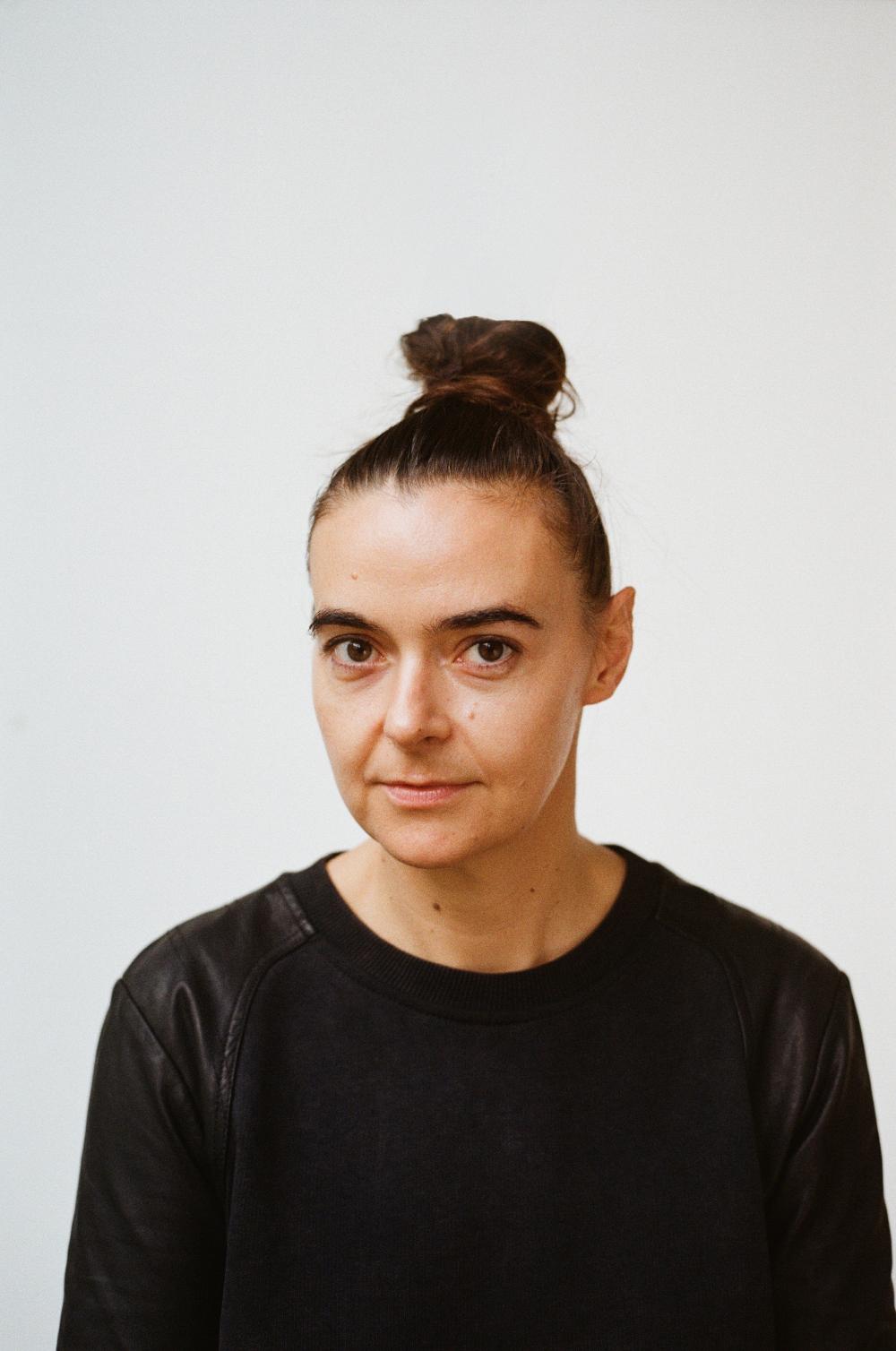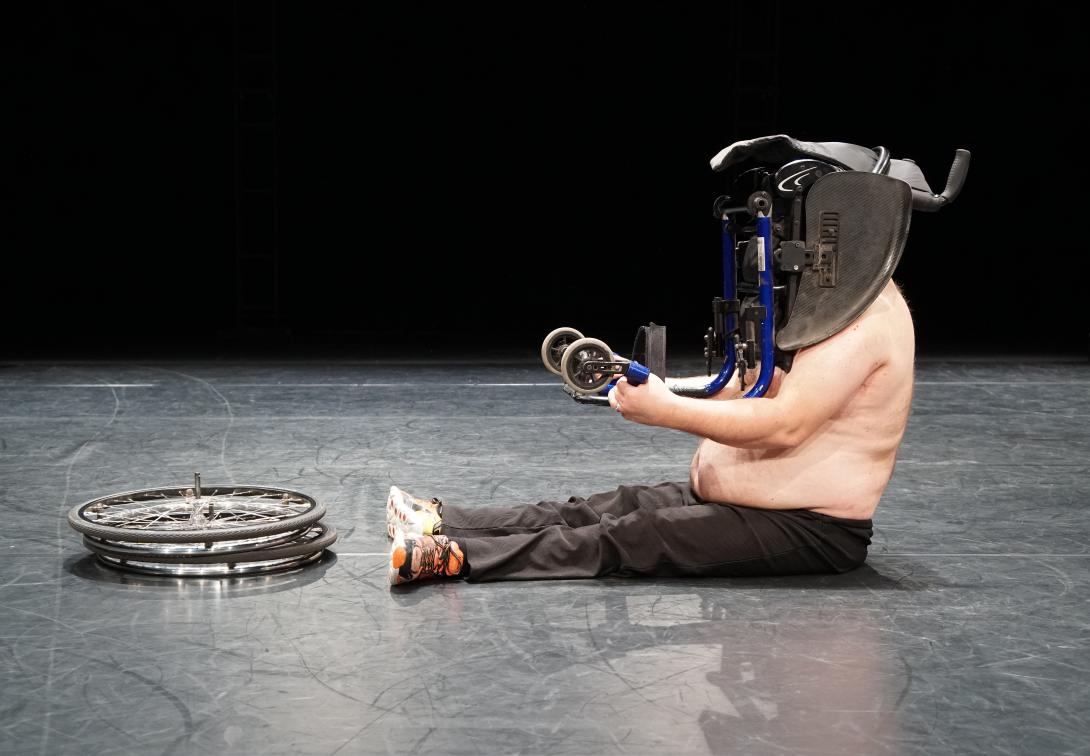My interest lies in flesh that moves, not flesh that poses.
A conversation with Doris Uhlich
What kinds of bodies do we generally see in dance productions and how do we look at them? Choreographer and dancer Doris Uhlich decided at a young age to break through the norms dictating dancing bodies. On 2/04, she is coming to Kaaitheater to present Every Body Electric, in which the performers all have a physical disability. Uhlich: ‘I’m more interested in the energy of a body than its outward appearance.’
The body is very present in your work and you often question the ‘ideal body’. Where does this interest come from?
I think the core of this interest lies in my own biography, when I started to dance at the age of eleven. I told my piano teacher that I had started taking dance classes, and she answered: ‘What? You, dancing, with your figure?’ Already then, being a corpulent young woman, I thought it was completely crazy that dance should only be possible and allowed for slim people. Later on I also often heard that my body does not fit the norm, but I have always continued to dance anyway. I decided that the dance for which slim bodies that conform are needed is perhaps not my kind of dance. But I was sure that I would find a dance that suited me, and if not, I’d make my own dance.
Even though these kinds of confrontations were painful, I soon started to question the body and how you can look at it. The outward appearance of a body is just one moment. There are millions of moments that exist within a body and how you perceive a body. I’m more interested in the energy of a body than its outward appearance.
You work with a varying set of bodies: the corpulent body, the gendered body, the naked body, the disabled body. Is there a leitmotif that connects all these different bodies?
Every body is a universe. I’m aware that every person I work with has a different body with its own complex system. Each time I look for an individual approach, searching for movements and a choreography that matches a body.
I see the body as a storage system in which we store our own biography and the biography of the world – the body is in the world, the world is in the body. The skin is not a closed system, it’s a very transparent tissue connecting our flesh to the vibes of the economic, political or social world.
You often work with nudity, sometimes even with large groups of people, or in public spaces. In that sense, you inscribe yourself in the whole history of art. At the same time, we see a new kind of prudishness among youngsters, who don’t want to take the risk of having their images circulating on the internet. What is your motivation for using nudity now?
When I am naked, I have the feeling that I get closer to the physical archive that I was talking about before. I can put my hand on my skin, get in closer touch with my archive. I can shake my flesh, shake up my storage system, my physical brain, I activate my physical thinking. Shaking and moving my flesh keeps my archive in motion and fear and blocked energies are able to shift.
It’s important that all kinds of naked bodies are visible, not only photoshopped bodies. When you are born, you are naked, it is a natural state of being. In my work, I don’t want to present myself naked onstage or in the public space, I want to be naked. It comes from a personal, political motor. A good example of this motor is how I started dancing naked. After a workout, I was putting away my sports bra and underwear and I saw my breasts bouncing and bottom wobbling. All of a sudden, I saw movement I had never seen before, because my clothes had been hiding it. It made me very happy, I really enjoyed that my fat started dancing. I turned on Madonna and I jumped around in my flat. I wanted to share my experience, so I started teaching naked classes, which was a new thing at that time. And these classes resulted in the show More Than Naked, which premiered in 2013.
My interest lies in flesh that moves, not flesh that poses. In my fatdance-technique, I search for the vibration of the flesh in all its variations. In the workshops, professional dancers and thin people also tried to wobble and shake. Suddenly, the thinner dancers said to the more corpulent dancers: ‘Wow, I would like to have your butt because it swings so well! It looks so beautiful!’ It was not a theory I thought through beforehand or a big concept of making a political workshop. It just happened that out of this joy and moment of liberation, there were suddenly very different ways of seeing bodies, questioning the mainstream, and disregarding one-sided thoughts and opinions about who is “beautiful”, “energetic” and worth looking at.
There is the fragility of working naked as a performer, but there is also the potential discomfort that the audience might feel when looking at naked people. Especially when the bodies are not the perfect bodies you normally see, like in Every Body Electric, in which you work with people with a physical disability. How do you deal with that?
When the audience feels discomfort, it doesn’t have to be a negative or frightening state. Theatre is a place for comfort and discomfort, a place for shifting perceptions, a place for transformation. I often hear that audiences who have watched Every Body Electric were confronted with their way of looking at the bodies onstage. So the piece is also about the spectator and his or her gaze. It also happens that after a while, the audience doesn’t see disabilities anymore, they see performers with other abilities. This turn is great.
In the rehearsal process of Every Body Electric, we started to work without nudity. It only came after weeks of rehearsing, because one of the performers had been part of a naked work of mine. She wanted to show herself to the group naked in her wheelchair, since she thought of her wheelchair as a body extension. When she is naked, she comes into closer contact with her extension. Afterwards, some of the others also wanted to try it. And I was surprised! I didn’t force them to show naked material in front of the audience, but I was there to support them with my expertise in naked performances to bring them into contact with the steel and the rubber of the tires. And still they decide, every time the piece is starting, whether they want to undress completely or not. It’s not fixed.
In Ravemachine, the piece on which Every Body Electric is based, we see you together with a physically disabled dancer onstage. Now, in Every Body Electric, there are only people with physical disabilities onstage. Why that evolution?
I was giving a workshop during Ravemachine for people with physical disabilities and it was a workshop only for them. Afterwards, we decided to keep on working together and developed Every Body Electric. When you think of inclusion, it means that you have a mixed ensemble onstage. We reflected a lot on our constellation, including on the fact that I as the choreographer have no disability, but we didn’t see and feel any problems with that. For me, it would have felt like make-up to ask new people without disabilities to join. Shortly before the première, we sat down together once more to think it through. Why should people with physical disabilities only be allowed to dance in mixed groups? We felt good in our constellation, we were very happy about our collaboration.
You call the movements you create with the performers ‘energetic icons’. Can you explain what they are? What importance does the energy level have for you? And how is techno music linked to it?
Energetic icons are individual and very personal movements. I call it ‘archaeology of energy’: you create movements that function like an indigenous fuel to load up your body. On the one hand, these are movements that bring you joy, pleasure and energy, but at the same time of course you lose energy through movement. You can’t stop because you love it, but you do get tired. The tiredness is something very positive though, because you feel you’re alive. An energetic icon is the movement that brings you this lively power. It is the movement your body loves at that moment. Even a small movement can create a high energy because it has a seismic quality. It can be something eruptive on a subtle level.
I started using techno music for my solo Universal Dancer because it dealt with the relation between the body and machines. In Every Body Electric, this relationship is still at stake so I’m using techno again. What I like about this music is its energetic flow and physical promise to last forever. You can mix the music for a very long time and you never hear the end of a sound or a tune. And since I heard that techno music was first called Electronic Body Music, I loved it even more!
To me, sound is like a partner in space. I like the image that music can enter the body through the skin. It can awaken the cells of pleasure and energy and it can help you to go into this archaeology of energy. It often feels like taking a bath in the waves of the sound.
You already spoke about the pleasure that the interaction between the body and technology produces. Do you also question the way bodies and technology are treated in society?
Technology is a very big word with many aspects that we could discuss. I would say that technology in the sense of medicine and enabling movement such as prosthetics technology is really worth going into and using.
Of course, the technology in Every Body Electric is a visible technology. And the technology which we all share is foremost an invisible technology: internet, bio-chemicals... There are technological tendencies I’m very critical about and tendencies of which I think it is very important that they exist. The danger in technology is that no matter if it’s visible or invisible, it costs money. Technology promises that it is reachable and consumable for everybody, but it isn’t. So who is technology for? For me the prospective is that rich and poor people will be deeply divided, in part because of technology. Technology includes and excludes people. We should be aware of these mechanisms.
A lot of your pieces are connected to one another, but you don’t frame them into series. Could you say something about that?
A good question doesn’t only have one answer. By staging a piece several times, you learn so much about it, and new aspects appear. It makes you go back to certain questions and pushes you to find new answers. I think an artistic path is not made of separate pieces and stones. It’s an echo land and I trust my echoes. I’m not afraid of repetition, continuation. It allows me to go deeper into something. In the performing arts, the market often gives you the feeling that you have to do new things. But what is new? I think something can become even better and deeper when you continue with it. For example: I’ll be naked until I die! When I’m old I’ll still be naked and thinking ‘how can I still wobble my flesh?’
A conversation with Doris Uhlich, by Katleen Van Langendonck and Eva Decaesstecker (Kaaitheater).

